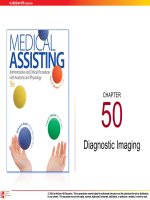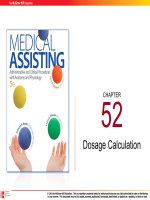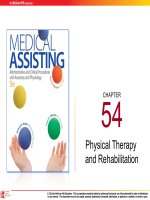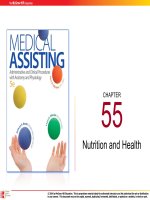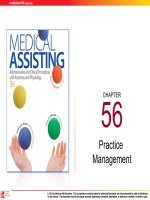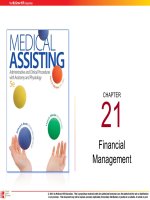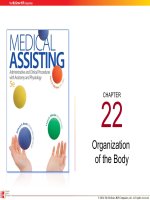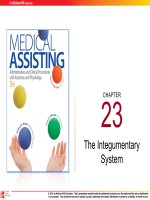Medical assisting Administrative and clinical procedures (5e) Chapter 51 Principles of pharmacology
Bạn đang xem bản rút gọn của tài liệu. Xem và tải ngay bản đầy đủ của tài liệu tại đây (1.08 MB, 54 trang )
CHAPTER
51
Principles of
Pharmacology
© 2014 by McGraw-Hill Education. This is proprietary material solely for authorized instructor use. Not authorized for sale or distribution
in any manner. This document may not be copied, scanned, duplicated, forwarded, distributed, or posted on a website, in whole or part.
51-2
Learning Outcomes
51.1 Identify the medical assistant’s role in
pharmacology.
51.2 Recognize the five categories of
pharmacology and their importance to
medication administration.
51.3 Differentiate the major drug categories,
drugs names, and their actions.
© 2014 by McGraw-Hill Education. This is proprietary material solely for authorized instructor use. Not authorized for sale or distribution
in any manner. This document may not be copied, scanned, duplicated, forwarded, distributed, or posted on a website, in whole or part.
51-3
Learning Outcomes
51.4 Classify over-the-counter (OTC),
prescription, and herbal drugs.
51.5 Use credible sources to obtain drug
information.
51.6 Carry out the procedure for registering or
renewing a physician with the Drug
Enforcement Administration (DEA) for
permission to administer, dispense, and prescribe
controlled drugs.
© 2014 by McGraw-Hill Education. This is proprietary material solely for authorized instructor use. Not authorized for sale or distribution
in any manner. This document may not be copied, scanned, duplicated, forwarded, distributed, or posted on a website, in whole or part.
51-4
Learning Outcomes
51.7 Identify the parts of a prescription, including
commonly used abbreviations and symbols.
51.8 Discuss nonpharmacological treatments for
pain.
51.9 Describe how vaccines work in the immune
system.
© 2014 by McGraw-Hill Education. This is proprietary material solely for authorized instructor use. Not authorized for sale or distribution
in any manner. This document may not be copied, scanned, duplicated, forwarded, distributed, or posted on a website, in whole or part.
51-5
Introduction
• Pharmacology – science or study of drugs
• Medication errors can result in injury or
death
• Medical assistant
– Knowledge of the foundations of
pharmacology
– Understand role of drugs in ambulatory
medical facilities
© 2014 by McGraw-Hill Education. This is proprietary material solely for authorized instructor use. Not authorized for sale or distribution
in any manner. This document may not be copied, scanned, duplicated, forwarded, distributed, or posted on a website, in whole or part.
Medical Assistant’s Role in
Pharmacology
51-6
• Prescription drugs vs. OTC drugs
• The medical assistant should
– Be sure the physician is aware of all
medications the patient is taking
– Ask patients about use of alcohol and
recreational drugs
– Provide patient education
© 2014 by McGraw-Hill Education. This is proprietary material solely for authorized instructor use. Not authorized for sale or distribution
in any manner. This document may not be copied, scanned, duplicated, forwarded, distributed, or posted on a website, in whole or part.
Medical Assistant’s Role in
Pharmacology (cont.)
51-7
• To administer drugs
– Check state regulations / scope of practice
– Understand pharmacologic principles
– Translate prescriptions
– Answer basic patient questions
– Adhere to legal requirements
– Keep accurate records
© 2014 by McGraw-Hill Education. This is proprietary material solely for authorized instructor use. Not authorized for sale or distribution
in any manner. This document may not be copied, scanned, duplicated, forwarded, distributed, or posted on a website, in whole or part.
51-8
Apply Your Knowledge
What is the role of the medical assistant in
pharmacology?
ANSWER: The medical assistant should be sure the
physician is aware of all medications the patient is
taking, including OTC medications; ask patients about
use of alcohol and recreational drugs; and provide
patient education. If the scope of practice permits, the
medical assistant may also be responsible for
administering some medications.
© 2014 by McGraw-Hill Education. This is proprietary material solely for authorized instructor use. Not authorized for sale or distribution
in any manner. This document may not be copied, scanned, duplicated, forwarded, distributed, or posted on a website, in whole or part.
51-9
Pharmacology
• Drug – chemical compound used to
prevent, diagnose, or treat disease
• Pharmacology – study of drugs
• Pharmachologist – specialist in
pharmacology
• Pharmacognosy
© 2014 by McGraw-Hill Education. This is proprietary material solely for authorized instructor use. Not authorized for sale or distribution
in any manner. This document may not be copied, scanned, duplicated, forwarded, distributed, or posted on a website, in whole or part.
51-10
Pharmacology
• Pharmacodynamics
• Pharmacokinetics
• Pharmacotherapeutics
• Toxicology
© 2014 by McGraw-Hill Education. This is proprietary material solely for authorized instructor use. Not authorized for sale or distribution
in any manner. This document may not be copied, scanned, duplicated, forwarded, distributed, or posted on a website, in whole or part.
51-11
Pharmacology (cont.)
• A physician prescribes a drug
• Administer a drug by any route that
introduces it into the patient body
• A healthcare professional
dispenses a drug
© 2014 by McGraw-Hill Education. This is proprietary material solely for authorized instructor use. Not authorized for sale or distribution
in any manner. This document may not be copied, scanned, duplicated, forwarded, distributed, or posted on a website, in whole or part.
51-12
Sources of Drugs (Pharmacognosy)
• Natural products
– Plants
– Animals
– Minerals
– Bacteria and fungi
• Chemical development
Foxglove – source of
digitoxin
– Synthesis of chemical makeup of a drug
– Manipulation of genetic information
© 2014 by McGraw-Hill Education. This is proprietary material solely for authorized instructor use. Not authorized for sale or distribution
in any manner. This document may not be copied, scanned, duplicated, forwarded, distributed, or posted on a website, in whole or part.
51-13
Pharmacodynamics
• Mechanism of action of a drug to produce
a therapeutic effect
• Drugs are categorized based on
mechanism of action
• Interaction between drug and their target
cells and the body’s response to the
interaction
© 2014 by McGraw-Hill Education. This is proprietary material solely for authorized instructor use. Not authorized for sale or distribution
in any manner. This document may not be copied, scanned, duplicated, forwarded, distributed, or posted on a website, in whole or part.
51-14
Pharmacokinetics
•
What the body does to a drug
– Absorption ~ conversion of a drug into a form
the body can use
– Distribution ~ transportation of a drug from
site of administration to site of action
© 2014 by McGraw-Hill Education. This is proprietary material solely for authorized instructor use. Not authorized for sale or distribution
in any manner. This document may not be copied, scanned, duplicated, forwarded, distributed, or posted on a website, in whole or part.
51-15
Pharmacokinetics (cont.)
– Metabolism
•
•
Drug molecules are transformed into
metabolites
Affected by age, genetic makeup, and
characteristics of drug
– Excretion
•
•
Manner in which a drug is eliminated from
the body
Most via urine
© 2014 by McGraw-Hill Education. This is proprietary material solely for authorized instructor use. Not authorized for sale or distribution
in any manner. This document may not be copied, scanned, duplicated, forwarded, distributed, or posted on a website, in whole or part.
51-16
Pharmacotherapeutics
• Indication and labeling
– Indication
• Reason for using a drug
• Must be approved by FDA to be part of labeling
– Labeling ~ includes drug form
– Off-label prescribing
© 2014 by McGraw-Hill Education. This is proprietary material solely for authorized instructor use. Not authorized for sale or distribution
in any manner. This document may not be copied, scanned, duplicated, forwarded, distributed, or posted on a website, in whole or part.
51-17
Pharmacotherapeutics (cont.)
• Safety
– Determined by adverse effects of a drug
– Be alert to patient complaints after starting a
new drug
• Efficacy – drug is working as expected
© 2014 by McGraw-Hill Education. This is proprietary material solely for authorized instructor use. Not authorized for sale or distribution
in any manner. This document may not be copied, scanned, duplicated, forwarded, distributed, or posted on a website, in whole or part.
51-18
Pharmacotherapeutics (cont.)
• Kinds of therapy
– Acute
– Prophylactic
– Empiric
– Replacement
– Maintenance
– Supportive
– Palliative
– Supplemental
© 2014 by McGraw-Hill Education. This is proprietary material solely for authorized instructor use. Not authorized for sale or distribution
in any manner. This document may not be copied, scanned, duplicated, forwarded, distributed, or posted on a website, in whole or part.
51-19
Toxicology
• Study of poisonous effects of drugs
– Adverse effects
– Drug interactions
• Patient education
– Inform physician of any adverse effects
– Discuss concerns with physician or
pharmacist
© 2014 by McGraw-Hill Education. This is proprietary material solely for authorized instructor use. Not authorized for sale or distribution
in any manner. This document may not be copied, scanned, duplicated, forwarded, distributed, or posted on a website, in whole or part.
51-20
Apply Your Knowledge
Matching:
ANSWER:
C Study of poisons
___
A Study of what the body does to
___
drugs
___
F Used to prevent, diagnose, or
treat disease
E Study of what drugs do to the
___
body
___
D Study of how drugs are used to
treat disease
B Study of characteristics of
___
natural drug and their sources
A. Pharmacokinetics
B. Pharmacognosy
C. Toxicology
D. Pharmacotherapeutics
E. Pharmacodynamics
F. Drugs
© 2014 by McGraw-Hill Education. This is proprietary material solely for authorized instructor use. Not authorized for sale or distribution
in any manner. This document may not be copied, scanned, duplicated, forwarded, distributed, or posted on a website, in whole or part.
51-21
Drug Names and Categories
• Drug names
– Generic
– International nonproprietary name
– Chemical name
– Trade
• Generic and trade names used most often
© 2014 by McGraw-Hill Education. This is proprietary material solely for authorized instructor use. Not authorized for sale or distribution
in any manner. This document may not be copied, scanned, duplicated, forwarded, distributed, or posted on a website, in whole or part.
51-22
Drug Names and Categories (cont.)
• Prescribed by either generic or trade
name
• Categorized by
– Action on the body
– General therapeutic effect
– Body system affected
© 2014 by McGraw-Hill Education. This is proprietary material solely for authorized instructor use. Not authorized for sale or distribution
in any manner. This document may not be copied, scanned, duplicated, forwarded, distributed, or posted on a website, in whole or part.
51-23
Apply Your Knowledge
What is the difference between the trade name
and generic name of a drug?
ANSWER:
Trade name – the brand or proprietary name chosen
by the manufacturer.
The generic name – the drug’s official name selected
by the U.S. Adopted Names (USAN) Council. It is
nonpropiretary.
Very Good!
© 2014 by McGraw-Hill Education. This is proprietary material solely for authorized instructor use. Not authorized for sale or distribution
in any manner. This document may not be copied, scanned, duplicated, forwarded, distributed, or posted on a website, in whole or part.
51-24
FDA Regulation and Drugs
• New drug approval
– Animal trials ~ toxicity
– Clinical trials ~ ratio of benefit to risk
• Regulation of drug manufacturing
– Drugs shipped between states
– Use exact formula approved
– Quality of ingredients
© 2014 by McGraw-Hill Education. This is proprietary material solely for authorized instructor use. Not authorized for sale or distribution
in any manner. This document may not be copied, scanned, duplicated, forwarded, distributed, or posted on a website, in whole or part.
51-25
FDA Regulation and Drugs (cont.)
• OTC drugs – nonprescription
• Prescription drugs
• Pregnancy categories
– Available information on risk to fetus
– Most drugs are Category C
• Complementary and alternative therapies
© 2014 by McGraw-Hill Education. This is proprietary material solely for authorized instructor use. Not authorized for sale or distribution
in any manner. This document may not be copied, scanned, duplicated, forwarded, distributed, or posted on a website, in whole or part.
